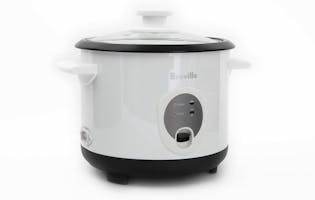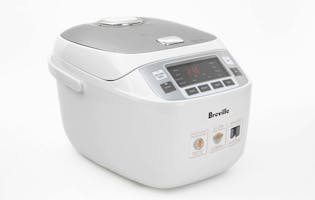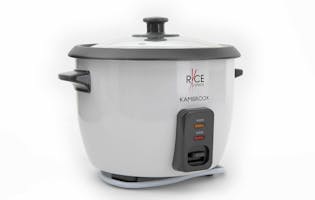Rice cookers
If you eat a lot of rice, you might want to invest in a rice cooker.
We’ve tested a range of rice cookers and found which perform best and are easiest to use.
Lifetime score
Our overall score combines test performance (how well the appliance works) with predicted reliability (how likely models from the brand are to remain free of faults) and owner satisfaction (how likely owners of the brand are to be very satisfied).
 We’ll only recommend appliances you’ll love to own, that work well and keep working well for a long time.
We’ll only recommend appliances you’ll love to own, that work well and keep working well for a long time.
Test performance
It’s no good if a product lasts several decades if it doesn’t work well in the first place. A disappointing product will soon become unloved and unwanted. For this reason, our independent lab testing forms an important part of our overall lifetime score.
Our test includes:
Cooking performance
We make brown rice and white (jasmine) rice in each rice cooker. Models with a capacity of 8 or more cups are tested with 4 cups of uncooked rice. Small to medium rice cookers are tested with 2 cups of uncooked rice.
The rice should be perfectly cooked with firm, separate grains. Brown rice should be slightly chewier than the white (jasmine) rice. There should be no water left after cooking and little or no browning in the bowl.
Ease of use
We assess how easy each rice cooker is to assemble, use and clean. We also check the temperature of the cooker’s exterior, handles and controls during operation.
Predicted reliability
It’s reasonable to expect a new appliance to remain fault-free for at least the first five years. Our predicted reliability won’t tell you whether your rice cooker will develop a fault tomorrow, but it does show which brands make models that are less likely to have issues.
Owner satisfaction
Satisfaction is important – no appliance should be a source of buyer regret. Appliances with very satisfied owners are more likely to get cleaned regularly and maintained well. Their owners are also more likely to seek repair for faults than look for a quick replacement.
Repairability (coming soon)
Older appliances are more likely to go wrong, but common faults should be repairable. Repairs should be affordable and convenient – parts need to be easy to find at a reasonable cost, instructions should be available, and repairs shouldn’t need hours of expert labour.
We haven’t been able to assess repairability yet, but it’s important, so we’re gathering data and forming a plan so we can start including it in our lifetime scores.
It will be challenging. We’ll need to analyse product failure data in our reliability surveys, conduct hands-on inspections to evaluate how easy products are to take apart, and investigate which brands make spare parts available at a reasonable price.
Survey data 101
In our annual reliability and satisfaction survey, consumers tell us about faults that have made an appliance they own unusable or mean they’ve had to change how they use it. We also ask them how satisfied they are with the appliance. We use this data to produce our predicted reliability and owner satisfaction scores.
We use a statistical test to rate the relative performance of each brand. Compared to data we have for all products (of the same type) in the survey, we rate each brand with excellent, good, average, poor or terrible for each of reliability and satisfaction.
You can compare the rating of different brands for the same product type (for example, the reliability rating for Miele and Haier washing machines), but you can’t compare the results for different product types (for example, satisfaction of LG TVs and Samsung phones).
We analyse brands that get at least 30 responses in our survey. That means there are some brands we can’t analyse because we don’t have enough data. For those brands, we assume they have average predicted reliability and owner satisfaction.
Our data is based on responses for 1,069 small cookers in our 2023 survey.
We've tested 8 rice cookers.
Find the right one for you.


